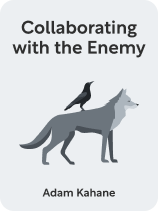

This article is an excerpt from the Shortform book guide to "Collaborating with the Enemy" by Adam Kahane. Shortform has the world's best summaries and analyses of books you should be reading.
Like this article? Sign up for a free trial here.
Do you have to collaborate with others at work or in school? Are you ever paired with someone you don’t see eye-to-eye with?
In Collaborating with the Enemy, conflict resolution expert Adam Kahane draws on his experience mediating high-stakes conflicts. Kahane’s “stretch collaboration” framework shows how to embrace both conflict and connection, experiment with different solutions when the path ahead isn’t clear, and focus on changing your contribution rather than trying to change others.
Keep reading to learn what stretch collaboration is and the principles that make up its framework.
Stretch Collaboration: Background
As our world becomes increasingly interconnected through globalization, technology, and social media, we encounter more people with different values, interests, and perspectives. These connections span our workplaces, communities, and political environments, and they create situations in which we must collaborate with people we don’t agree with, like, or trust. For these challenging situations, Kahane introduces “stretch collaboration” as an alternative to traditional approaches.
He explains that traditional collaboration typically assumes three things: that we must focus on harmony and suppress conflict within the team; that we must agree on a detailed plan before taking action; and that we can change what others are doing if we try hard enough. While these assumptions might work in simple situations with like-minded people, Kahane explains that they fail in complex, contentious environments.
Kahane says that stretch collaboration addresses these limitations by requiring us to move beyond our comfort zones in three specific ways:
- Acknowledge both differences and connections. Rather than forcing artificial harmony, we must recognize conflicts while also building genuine relationships.
- Adopt an adaptive, iterative approach. Instead of insisting on agreement about a predetermined plan, we should try different possibilities through a process of testing and learning.
- Focus on changing your contribution. We should direct our energy toward changing our own behavior rather than trying to change others.
This approach recognizes that in complex situations, we can’t control what happens, but we can influence it through our participation. It requires us to hold seemingly contradictory ideas in tension: We must assert our interests while engaging with others, and we must accept the situation as it is while working to change it. Stretch collaboration enables us to balance our priorities and work with others in situations where conventional collaboration would break down.
| Why Did We Evolve the Ability to Reason? Because of the Need for Collaboration The paradox of stretch collaboration—that we must simultaneously accept reality while trying to change it—mirrors a deeper human challenge that we’ve dealt with since forming our earliest social groups: balancing our individual needs with the needs of the tribe. This tension has shaped our cognitive evolution in ways researchers are just beginning to untangle. Traditionally, we’ve assumed our ancestors evolved reasoning skills to help them think better individually. But in The Enigma of Reason, Hugo Mercier and Dan Sperber argue that reasoning developed as a social tool to help us work together in groups with complex dynamics, which was crucial to our survival. Mercier and Sperber explain that our “hypersociality” gave us evolutionary advantages that allowed us to cooperate, but it also created the challenge of working with others whose interests don’t align with our own. Reasoning helps us manage this by letting us see both our differences and our common ground, as Kahane suggests. Instead of trying to do everything ourselves, the ability to reason helps us learn by trying things together and adjusting along the way. Instead of trying to change others’ behavior, reason lets us recognize the limits of our influence and change how we act—something our ancestors had to learn for successful tribal living. |
How to Use Stretch Collaboration
Now that we’ve explained what stretch collaboration is, let’s explore how to put Kahane’s principles into practice. Adopting a stretch collaboration approach requires three fundamental shifts in how we work with others, especially those we see as adversaries. Let’s examine each of these principles in depth.
Principle #1: Acknowledge Both Differences and Connections
First, Kahane explains that effective collaboration requires both embracing conflicts and nurturing relationships. He contends that all human interactions are shaped by two fundamental drives: the drive for power and the drive for love.
Kahane contends that most of us overemphasize one drive at the expense of the other, with negative effects on our ability to collaborate effectively. People who focus primarily on power create fragmentation and resistance; those who focus primarily on love suppress important differences and create artificial harmony. This artificial harmony manifests as superficial agreements that lack real commitment, unaddressed tensions that inevitably resurface, and a false sense of consensus that masks genuine differences.
(Shortform note: Political scientist Hans Morgenthau viewed the drives for power and love as emerging from the same source: our fundamental human isolation. He argued that we all feel unable to fulfill ourselves in isolation from others. By seeking power, we attempt to overcome this loneliness by making others mirror our will. By pursuing love, we try to address our loneliness by building connections. This perspective highlights why Kahane’s advice to alternate between these drives works better than emphasizing either one. When we overemphasize power, we express a frustrated need for connection; when we enforce artificial harmony, we paradoxically wield power over others.)
With stretch collaboration, we alternate between the drives for love and power rather than trying to hold them simultaneously, giving both conflicts and connections the space they need to be fully understood. Sometimes you need to assert your position forcefully; at other times, you need to step back and engage with others’ perspectives.
(Shortform note: Kahane’s principle of alternating between power and love mirrors Buddhist wisdom about balancing opposing forces and holding contradictory ideas. In Buddhism, power isn’t inherently negative: It’s neutral energy that needs wisdom to guide it. Without compassion, power becomes aggression; without strength, love becomes ineffectual. This balance is echoed in Buddhist monk Thich Nhat Hanh’s teachings on mindfulness, which blend assertiveness (speaking truth) and engagement (deep listening). This balance allows us to stand firm in our convictions while remaining open to others. By recognizing when to assert and when to engage, both conflict and connection become sources of creative possibility.)
Kahane explains that in complex collaborations, conflicts aren’t just inevitable; they’re necessary. They arise from genuine differences in perspectives, interests, and values that we need to acknowledge. Without surfacing these differences, we miss opportunities for creative solutions that could emerge from the productive engagement of diverse viewpoints. At the same time, without connection, conflicts become destructive rather than generative. Connection provides the trust necessary to engage honestly with differences, the resilience to weather disagreements without breaking apart, and the shared context that makes collaborative action possible.
| Creative Conflict as Community Building Kahane’s emphasis on embracing conflict echoes perspectives from social activists who see tension as essential to community-building. In The Fantasy and Necessity of Solidarity, Sarah Schulman—who worked with the AIDS Coalition to Unleash Power (ACT UP) during the AIDS crisis—argues that effective solidarity requires maintaining connection through disagreement rather than seeking artificial harmony. In her analysis of social movements, she observes that people often have unrealistic expectations that their activism will be effective, won’t come with any social costs, and will be met with gratitude. These expectations—like those of conflict-free teamwork—are fantasies that can undermine collaborative efforts. For both Schulman and Kahane, meaningful collaboration requires abandoning the fantasy of harmony and embracing tension as being generative rather than destructive. ACT UP’s success despite significant internal differences highlights how acknowledging conflicts while maintaining relationships can make space for creative solutions that might never emerge from enforced consensus. |
Principle #2: Try an Adaptive, Iterative Approach
Kahane explains that stretch collaboration requires abandoning the illusion of control through detailed planning and instead allowing solutions to emerge through action and learning. Conventional collaboration assumes we can agree on a detailed plan before taking action, but this assumption fails in complex situations for several reasons: First, no one actually knows what will work until it’s tried. Second, different people have different ideas about what should happen. Third, situations are constantly evolving, making static plans quickly obsolete. And perhaps most importantly, possibilities that couldn’t be anticipated in the planning stage often emerge when putting plans into action.
Instead of trying to control the future through planning, stretch collaboration involves systematically experimenting with different possibilities and adapting based on what you learn. This approach recognizes that in complex situations, the way forward can only be discovered by walking it.
(Shortform note: While Kahane emphasizes abandoning detailed plans, French clothing design workshops reveal a key nuance: Creative experimentation often requires more structure, not less. In these workshops, rigorous systems support the experimental process—clear hierarchies among craftspeople, specialized divisions of labor, and methodical stages like creating designs before final garments. But within this framework, the actual interpretation of designer sketches remains highly experimental. This suggests that collaborators might focus less on eliminating planning and more on making the right kinds of plans—ones that establish boundaries, resources, and rhythms for experimentation while preserving freedom within those parameters.)
Principle #3: Focus on Changing Your Own Contribution
The third principle of stretch collaboration focuses on what’s entirely within our control: our own participation in the situation. Rather than trying to change others—which is often futile and frustrating—stretch collaboration requires us to step into the game and change ourselves.
Conventional collaboration often devolves into finger-pointing and blame. We focus on what others are doing wrong and how they need to change: “If only the other department would communicate better,” or “If only our partners would fulfill their commitments.” This approach is fundamentally disempowering because it places responsibility for progress on factors outside our control. It also makes others defensive, which makes them less likely to change.
(Shortform note: Effective collaboration may require an additional step that’s absent from Kahane’s framework—processing disappointment before shifting our focus to what we can control. In Jonathan Safran Foer’s short story “The Sixth Borough,” New York residents face a situation beyond their control when a neighboring borough drifts away despite attempts to anchor it. Before they can act, they must mourn what they’re losing: Many didn’t want their city to change, just as we get attached to how we want things to be. Unable to save the entire borough, the New Yorkers pull Central Park from the Sixth Borough into Manhattan, suggesting that sometimes we don’t just have to alter our behavior, but also reimagine our goals.)
Stretch collaboration requires shifting our focus from changing others to changing our own contribution to the problematic situation. This doesn’t mean accepting all responsibility or ignoring others’ actions; it means recognizing that the only element we can directly control is our own behavior. When you change your participation, it creates ripple effects. Every social system (team, organization, or community) develops habitual patterns of interaction. When you change your part in these patterns, it creates openings for new dynamics. While you can’t directly control how others act, your behavior creates incentives and opportunities for them to respond differently. By changing yourself, you make it easier for others to change as well.
(Shortform note: To understand how one person can create ripple effects through an entire social system, imagine a mangrove tree. Mangroves don’t just passively exist in their coastal environment—they transform it. Their complex root systems filter water, trap sediments, and create entirely new habitats for countless species. What starts as a single tree’s adaptation can transform an entire coastline over time. Similarly, the Bronfenbrenner ecological model shows that your interactions directly affect your immediate environment, which then influences broader social contexts—and changes established patterns of interaction. When you change how you participate, you’re creating new conditions that change how others respond to you.)
Kahane identifies three specific ways we can change how we participate in collaborative situations:
First, you can change how you look at the situation by recognizing that your perspective is just one of many valid viewpoints. Do this by challenging your assumptions about others’ motivations and intentions. Look for your blind spots and how they affect your understanding. Consider how you might be contributing to the very problems you’re criticizing.
(Shortform note: Recognizing that your perspective is just one of many valid viewpoints is perhaps the most difficult shift required for stretch collaboration. In “The Incredible Buddha Boy,” George Saunders observes that our minds constantly ask what we would prefer rather than trying to understand what is. To Buddhists, transcendence means getting out of the habitual patterns we normally inhabit. This is what Kahane also asks us to do: Saunders describes how we possess multiple energies and perspectives within ourselves, and this multiplicity mirrors the diversity of perspectives we encounter in others. Collaboration requires not just acknowledging other viewpoints, but actively working against the mind’s tendency to center itself in every story.)
Second, you can transform how you talk and listen by moving beyond downloading (speaking from fixed positions) to more generative modes. Practice dialoguing: Speak authentically about your experience rather than abstractly about “the facts.” Develop the capacity for presencing: Listen for emerging possibilities rather than just confirming what you already believe. Incorporate more genuine questions and fewer definitive statements in your communication.
Third, you can modify your actions by experimenting with different behaviors and noticing their effects. Take risks by stepping outside your usual role or position. Make unilateral moves toward the outcome you want to see. Model the collaborative behavior you want others to adopt—not as a manipulation tactic, but as a genuine commitment to changing the dynamic.
| Surrendering Control to Change Ourselves While Kahane focuses on changing our actions, the film Groundhog Day reveals another dimension: the internal transformation that precedes behavioral change. In this 1993 comedy, weatherman Phil Connors (Bill Murray) becomes trapped in a supernatural time loop, forced to relive February 2nd over and over again. No matter what he does during the day—whether constructive or destructive—he wakes up each morning to the same radio song, the same people, and the same events. Initially, he responds with frustration, then hedonism (using his knowledge of the day’s events for personal gain), and eventually despair—feeling that nothing he does matters and nothing will ever change. But after countless repeated days, Phil finally accepts his lack of control over his situation. This frees him to experiment with new ways of engaging with others: Instead of manipulating outcomes or people, he begins developing genuine skills (piano playing, ice sculpting) and performing acts of service throughout the town. Similarly, in difficult collaborations, surrendering to our lack of control might free us to participate in new ways. When we stop trying to change others or to manipulate outcomes, we can focus on what we can genuinely contribute. Like Phil, whose loop only breaks when he finds meaning in connection, we might learn that changing how we participate creates new possibilities for collaboration. |

———End of Preview———
Like what you just read? Read the rest of the world's best book summary and analysis of Adam Kahane's "Collaborating with the Enemy" at Shortform.
Here's what you'll find in our full Collaborating with the Enemy summary:
- Why you don't need to like or trust someone in order to collaborate with them
- How to use the stretch collaboration framework to successfully work with anybody
- Why you should put your tensions out in the open rather than ignoring them






